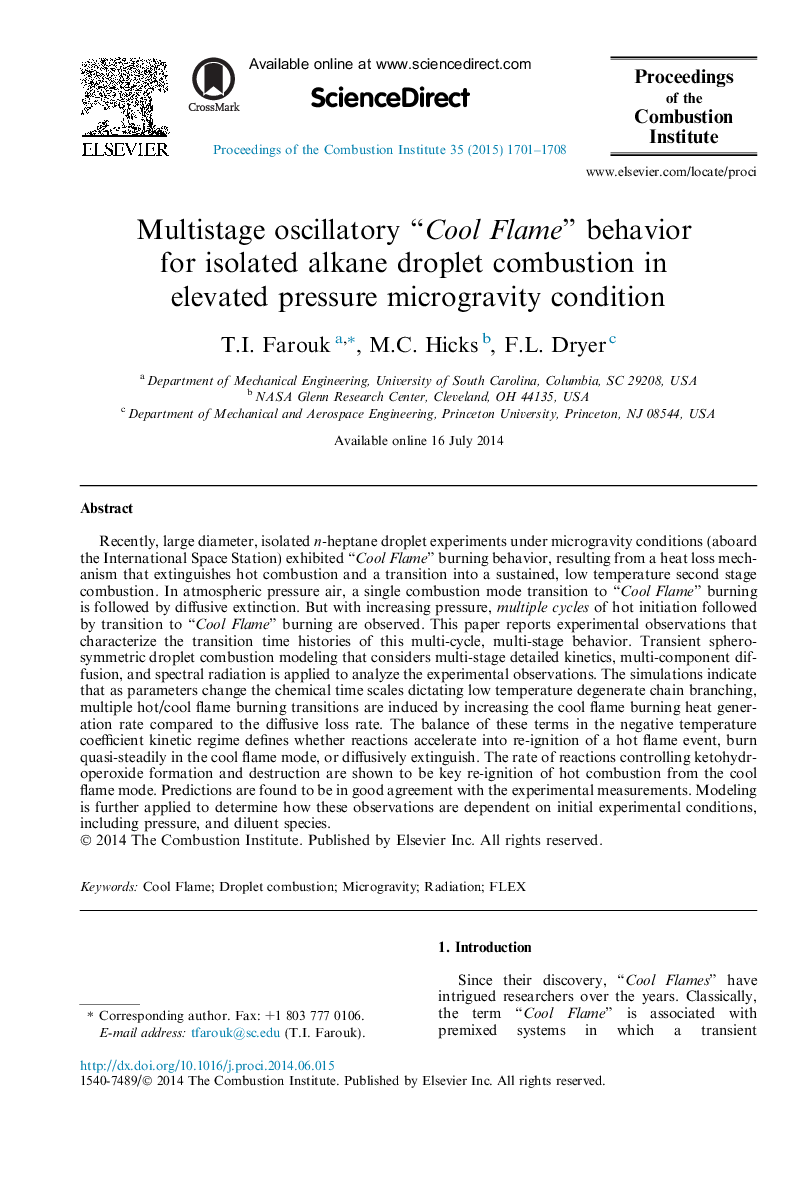| کد مقاله | کد نشریه | سال انتشار | مقاله انگلیسی | نسخه تمام متن |
|---|---|---|---|---|
| 6679293 | 1427920 | 2015 | 8 صفحه PDF | دانلود رایگان |
عنوان انگلیسی مقاله ISI
Multistage oscillatory “Cool Flame” behavior for isolated alkane droplet combustion in elevated pressure microgravity condition
ترجمه فارسی عنوان
نوسان چند مرحله ای؟ رفتار احتراق قطره ای آلکان در شرایط میکرو گرانشی فشار بالا
دانلود مقاله + سفارش ترجمه
دانلود مقاله ISI انگلیسی
رایگان برای ایرانیان
کلمات کلیدی
موضوعات مرتبط
مهندسی و علوم پایه
مهندسی شیمی
مهندسی شیمی (عمومی)
چکیده انگلیسی
Recently, large diameter, isolated n-heptane droplet experiments under microgravity conditions (aboard the International Space Station) exhibited “Cool Flame” burning behavior, resulting from a heat loss mechanism that extinguishes hot combustion and a transition into a sustained, low temperature second stage combustion. In atmospheric pressure air, a single combustion mode transition to “Cool Flame” burning is followed by diffusive extinction. But with increasing pressure, multiple cycles of hot initiation followed by transition to “Cool Flame” burning are observed. This paper reports experimental observations that characterize the transition time histories of this multi-cycle, multi-stage behavior. Transient sphero-symmetric droplet combustion modeling that considers multi-stage detailed kinetics, multi-component diffusion, and spectral radiation is applied to analyze the experimental observations. The simulations indicate that as parameters change the chemical time scales dictating low temperature degenerate chain branching, multiple hot/cool flame burning transitions are induced by increasing the cool flame burning heat generation rate compared to the diffusive loss rate. The balance of these terms in the negative temperature coefficient kinetic regime defines whether reactions accelerate into re-ignition of a hot flame event, burn quasi-steadily in the cool flame mode, or diffusively extinguish. The rate of reactions controlling ketohydroperoxide formation and destruction are shown to be key re-ignition of hot combustion from the cool flame mode. Predictions are found to be in good agreement with the experimental measurements. Modeling is further applied to determine how these observations are dependent on initial experimental conditions, including pressure, and diluent species.
ناشر
Database: Elsevier - ScienceDirect (ساینس دایرکت)
Journal: Proceedings of the Combustion Institute - Volume 35, Issue 2, 2015, Pages 1701-1708
Journal: Proceedings of the Combustion Institute - Volume 35, Issue 2, 2015, Pages 1701-1708
نویسندگان
T.I. Farouk, M.C. Hicks, F.L. Dryer,
